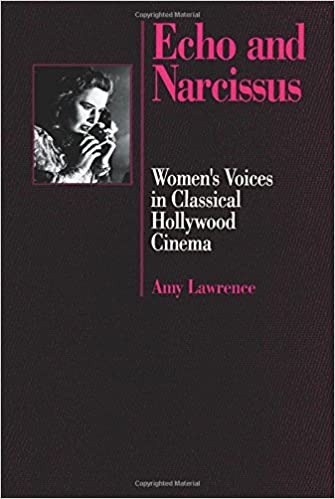Echo and Narcissus: Women's Voices in Classical Hollywood Cinema Review Rubric

Overview
This is a review of
Lawrence, Amy. Echo and Narcissus: Women's Voices in Classical Hollywood Cinema. Berkeley: University of California Press, c1991 1991. http://ark.cdlib.org/ark:/13030/ft2x0nb1hx/
https://www.merlot.org/merlot/viewMaterial.htm?id=1012746
completed by Alyson Blythe, Assistant Professor of English/Humanities Coordinator at Fletcher Technical Community College.
Comprehensiveness
The text covers all areas and ideas of the subject appropriately and provides an effective index and/or glossary.
The text is a collection of essays (6) on “Speaking Women” or “Women’s Speech” in Cinema, with particular focus on several classic stories including Rain, To Kill a Mockingbird, and several mystery/thrillers (such as Hitchcock). Chapter 1 essay discusses the historical context of women’s voices, linking technology advances to the gendering of voices according to the standards of the time. The following five essays discuss women’s speech within the context of several specific films. It would be helpful to see a second edition of this with more recent film samples references. Includes Notes, Filmography, and a detailed Index.
Content Accuracy
Content is accurate, error-free and unbiased.
Content is concise but detailed sufficiently so that students will understand key concepts. Some of the more technical aspects of the discussion are simplified/explained clearly.
Relevance Longevity
Content is up-to-date, but not in a way that will quickly make the text obsolete within a short period of time. The text is written and/or arranged in such a way that necessary updates will be relatively easy and straightforward to implement.
This text is narrowly focused to analyzing women’s voices in a selection of nine films from the limited cinematic period of 1928-62. Resource is mainly supplemental to more robust content.
Clarity
The text is written in lucid, accessible prose, and provides adequate context for any jargon/technical terminology used.
The text is clear and not overly flowery or technical. Some cinematic jargon is used, but its meaning is mostly clear in context.
Consistency
The text is internally consistent in terms of terminology and framework.
Collection of essays is by the same author, so the tone of voice, terminology, and structure/focus are consistent throughout.
Modularity
The text is easily and readily divisible into smaller reading sections that can be assigned at different points within the course (i.e., enormous blocks of text without subheadings should be avoided). The text should not be overly self-referential, and should be easily reorganized and realigned with various subunits of a course without presenting much disruption to the reader.
As this is a collection of essays previously published in other sources and meant as stand-alone works, the sections are easily divisible and can be tailored to specific assignments/readings. However, as each essay’s content is rather specific, this source is more appropriate for upper level film courses as opposed to an Introduction to Film course.
Organization Structure Flow
The topics in the text are presented in a logical, clear fashion.
This text is a collection of essays centered on the idea of “women’s speech” or “women’s voices” in cinema. Chapter 1 provides an overview/thesis for the collection with subsequent sections focusing on the analysis of a classic, often female-centric, film. In particular, Chapter 6 provides an in-depth analysis of the film To Kill a Mockingbird (1962), with specific attention to character types such as The Lawyer/Father, The Bad Father, and the Narrator and how each impacts the female voice in the story.
Interface
The text is free of significant interface issues, including navigation problems, distortion of images/charts, and any other display features that may distract or confuse the reader.
Text is easy to access/read. Mostly text, with minimal black and white phots for illustration purposes.
Grammatical Errors
The text contains no grammatical errors.
The text contains no grammatical errors. The text is engaging and the content is not overly technical or complex. However, some knowledge of cinematic vocabulary (not defined in the articles) is required as such terms are used within the articles.
Cultural Relevance
The text is not culturally insensitive or offensive in any way. It should make use of examples that are inclusive of a variety of races, ethnicities, and backgrounds.
Taking its title from Roman mythology, the essays discuss the importance of women’s voices within a historical context while establishing how modern film technology has given women a wider voice. However, the scope of examples focused on is limited to classic films (1928-62) that primarily feature white characters.
Comments
This text was reviewed for the English course Introduction to Women’s Literature for a section on Women in Cinema. Specifically, “Chapter 6: Women and the Authorial Voice: Disembodied Desire: To Kill a Mockingbird (1962)” will be utilized in this course. Possible additional inclusion in this course or Introduction to Film, is “Chapter 4: The Problem of the Speaking Woman: The Spiral Staircase (1946), Blackmail (1929), Notorious (1946), Sorry, Wrong Number (1948)”.